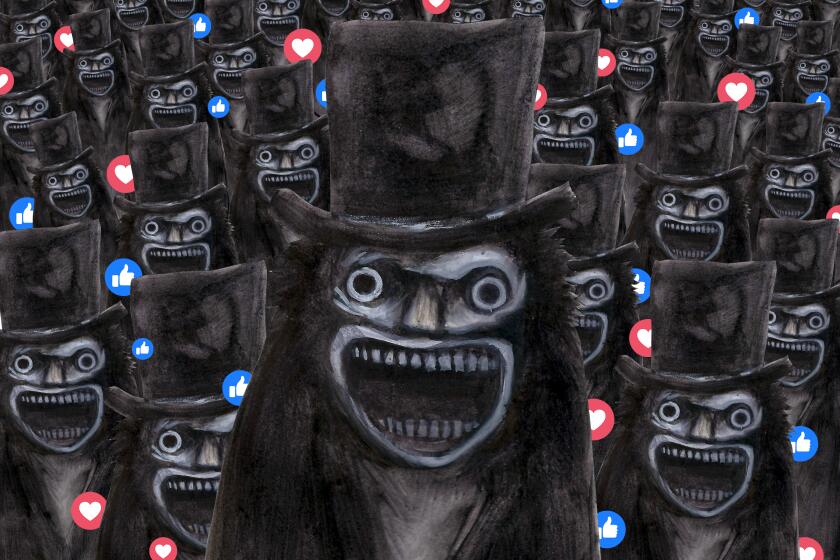Review: Vive ‘Les Miserables’ in all its over-the-top glory
The people who put “Les Misérables” on screen dreamed a mighty dream, they really did. They dreamed of filming one of the most popular of modern theatrical musicals — 60 million tickets sold in 42 countries and 21 languages since its 1980 Paris debut — in a way that had not been done before, enhancing the emotion of what was already a hugely emotional piece. And, despite some built-in obstacles, they succeeded to a surprising extent.
The biggest obstacle to their success, paradoxically, was the show itself, a whopper of a tale wrestled from Victor Hugo’s massive novel. Though the production’s songs are celebrated, the dialogue between them is not, while the plot veers toward shameless and the characters can come off as one-dimensional.
To counter all this, director Tom Hooper (in his first film since the Oscar-winning “The King’s Speech”) has doubled down on the piece’s greatest strength, finding ways to magnify the musical’s ability to create those waves of overwhelming feelings in an audience. So if unashamed, operatic-sized sentiments are not your style, this “Les Miz” is not going to make you happy.
PHOTOS: ‘Les Miserables’ | New York premiere
Working from a script by William Nicholson and the creators of the English-language version (Alain Boublil, Claude-Michel Schonberg and Herbert Kretzmer), Hooper has first of all fearlessly opened the play up, convincingly placing it in an indisputably real world. From its first scene, a fantastic image of a horde of French convicts, circa 1815, trying to pull a floundering ship into an enormous dry dock in the midst of a mighty storm, this production is visual to the max, with an epic physical scale and grandeur the play couldn’t possibly have.
The second strategy employed was to sign the best, most convincing actors for these unsophisticated roles and to assist them in making the characters real by investing in them heart and soul. For protagonist Jean Valjean, that meant the protean Hugh Jackman, initially unrecognizable as a full-bearded emaciated convict — No. 24601 to be precise — who is part of the crowd wrestling with the struggling vessel.
Jackman’s lean and hungry look was no accident, the actor has said, relating that director Hooper told him, “I need you to get to where your friends stop you and ask, ‘Are you OK? Are you sick?’ Until you get to that point, you haven’t gone far enough.”
Also front and center in that initial scene is Javert, the cold-hearted representative of the law, here played by Russell Crowe, an actor who pretty much defines implacable. Once the boat is safely hauled in, Javert tells Valjean that, after serving 19 years in prison for stealing a loaf of bread to feed his family, he is being released, albeit to a life of constantly being marked as a dangerous ex-convict. “Do not forget my name,” Javert says to the man, as if that were even an option.
VIDEO: The Envelope Screening Series | ‘Les Miserables’
Except Crowe’s Javert doesn’t say it, he sings it right there in front of us. Perhaps the key change Hooper made in the way movie musicals are usually put together is his insistence that the singing the audience hears is the actors performing live on the set at the time of filming, not weeks earlier in a recording studio. That allows them to bring the rich emotion of their entire performances to celebrated songs such as “Who Am I” and “One Day More.”
Hooper believes, as he told an early Los Angeles screening audience, that “singing gives access to a deeper emotional range,” but that doesn’t mean that this was in any way easy. The director revealed that the actors wore two radio microphones outside their costumes, so that no matter which way their heads turned, the sound would be accurately recorded. All that remained was to “digitally paint them out” frame by frame by frame.
All that painstaking work was definitely worthwhile, making the singing as intense and personal as possible, something that pays off as “Les Misérables’” way melodramatic plot gets increasingly wild and crazy.
The scene now shifts to 1823 and a town in France where, helped by a kindly bishop (Colm Wilkinson, the original London and Broadway Valjean) and his own decision to break parole, Valjean has taken on a new identity and become a wealthy factory owner. Easy street, however, is about to end.
For one thing, Javert turns up in town, and he smells a rat. For another, one of Valjean’s female employees, Fantine, is wrongfully sacked and ends up selling her hair and her teeth and becoming a prostitute. Though this series of events practically defines over-the-top plotting, Anne Hathaway, who plays Fantine, does such a knockout rendition of the showstopper “I Dreamed a Dream” that objecting is out of the question.
PHOTOS: Hollywood back lot moments
Forced to flee town, Valjean vows to raise Fantine’s illegitimate daughter, ultimate waif Cosette (Isabelle Allen), as his own. First however, he has to pry her out of the hands of ultimate rascals Monsieur and Madame Thenardier, played by Sacha Baron Cohen and Helena Bonham Carter in the “Master of the House” number that is not as much fun as it thinks it is.
All these plot strands come together nine years later in Paris of 1832, where Cosette, now a beautiful young woman (Amanda Seyfried), catches the eye of passionate would-be revolutionary Marius (a terrific Eddie Redmayne, who does a splendid “Empty Chairs at Empty Tables”). He in turn is admired from afar by the lovelorn Eponine (Samantha Barks, equally good in “On My Own”). Will love conquer all? Do you even have to ask?
Because it is so shameless and so popular, “Les Misérables” and its “to love another person is to see the face of God” theme are tailor-made for mockery. But despite its pitfalls, this movie musical is a clutch player that delivers an emotional wallop when it counts. You can walk into the theater as an agnostic, but you may just leave singing with the choir.
---------------------------------
‘Les Miserables’
MPAA rating: PG-13 for suggestive and sexual material, violence and thematic elements
Running time: 2 hours, 38 minutes
Playing: In general release
PHOTOS AND MORE
VIDEO: The making of ‘Argo,’ ‘Les Miz’ and more
VIDEO: Holiday movies - A video guide
PHOTOS: NC-17 movies: Ratings explained
More to Read
Only good movies
Get the Indie Focus newsletter, Mark Olsen's weekly guide to the world of cinema.
You may occasionally receive promotional content from the Los Angeles Times.











